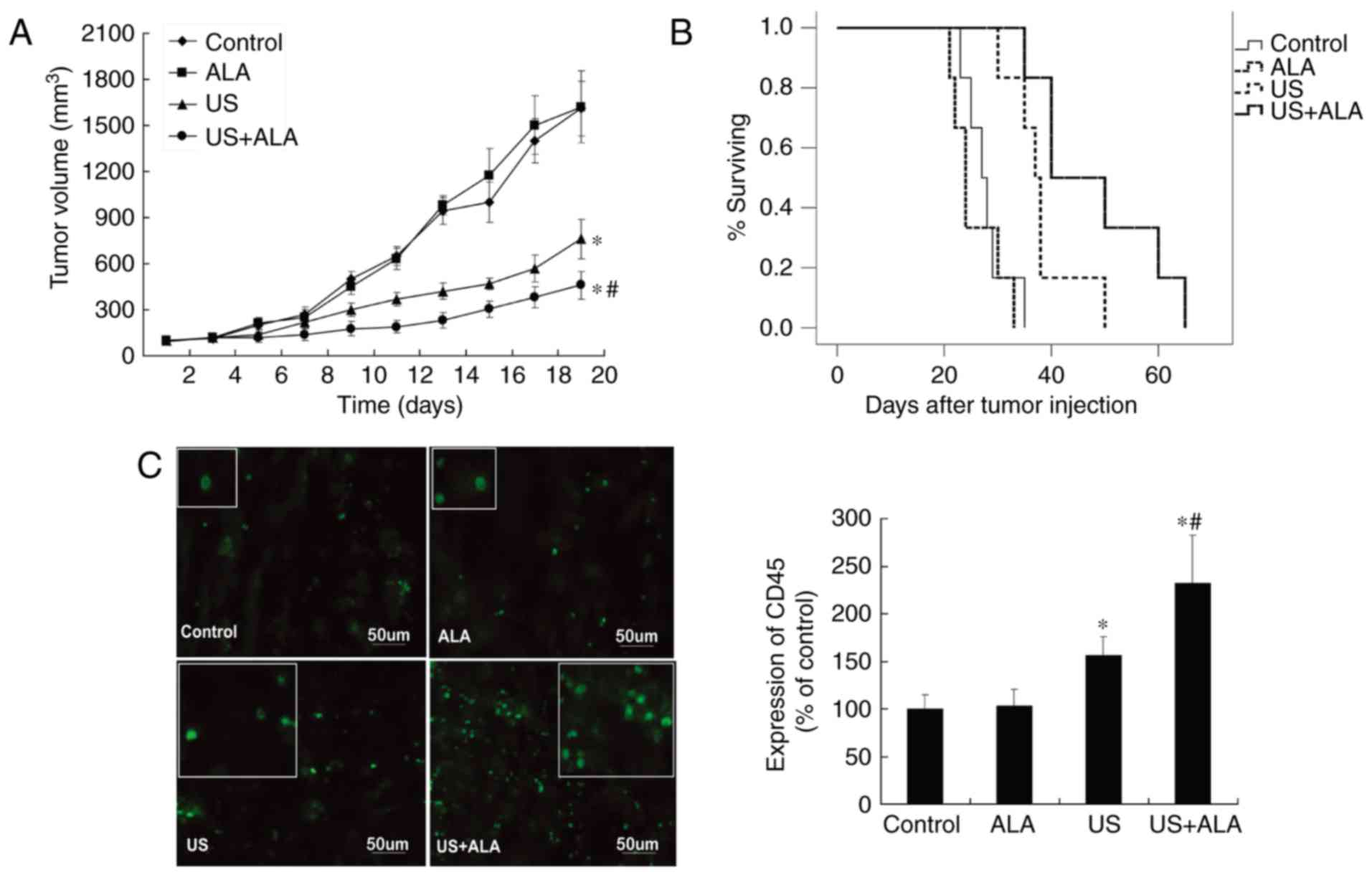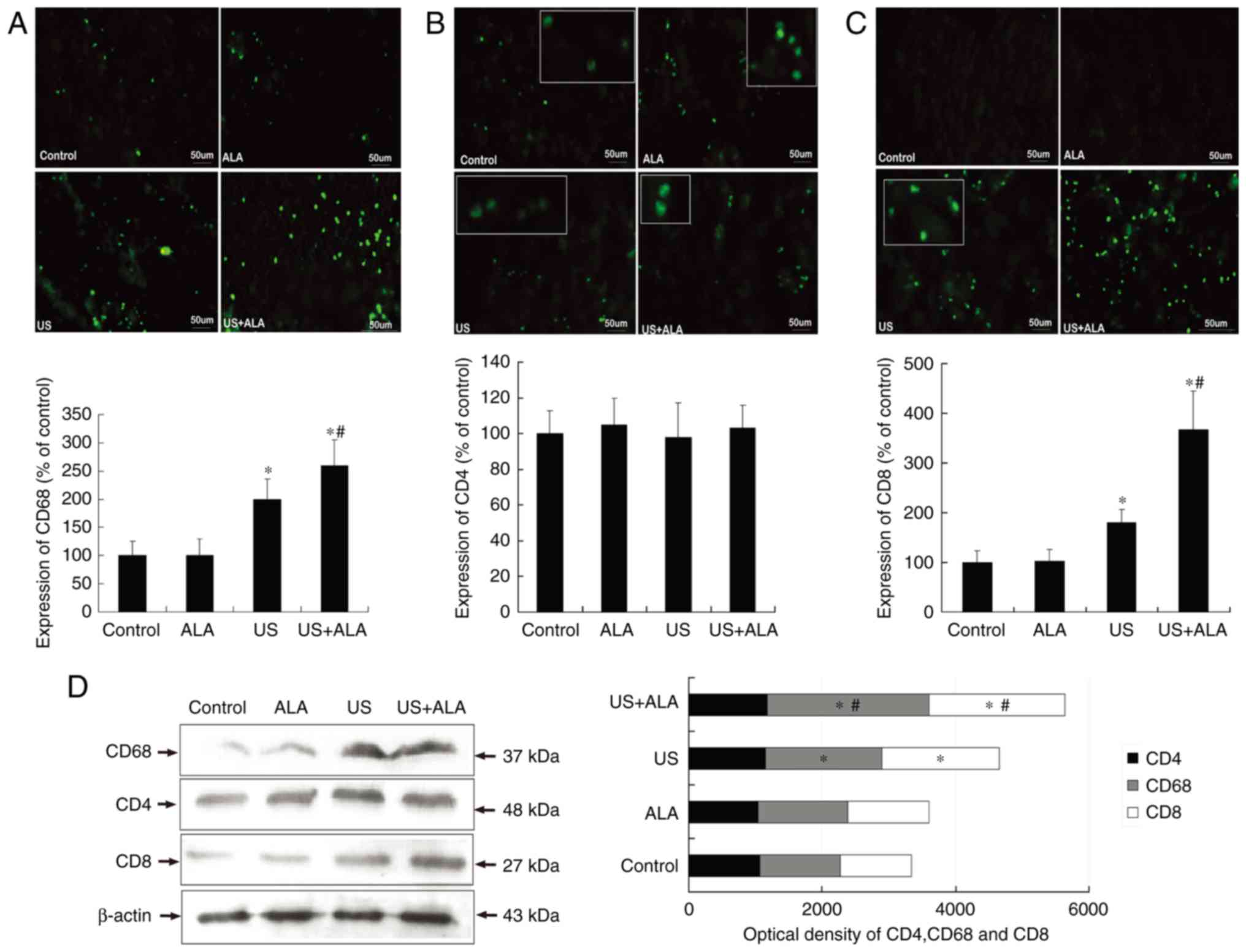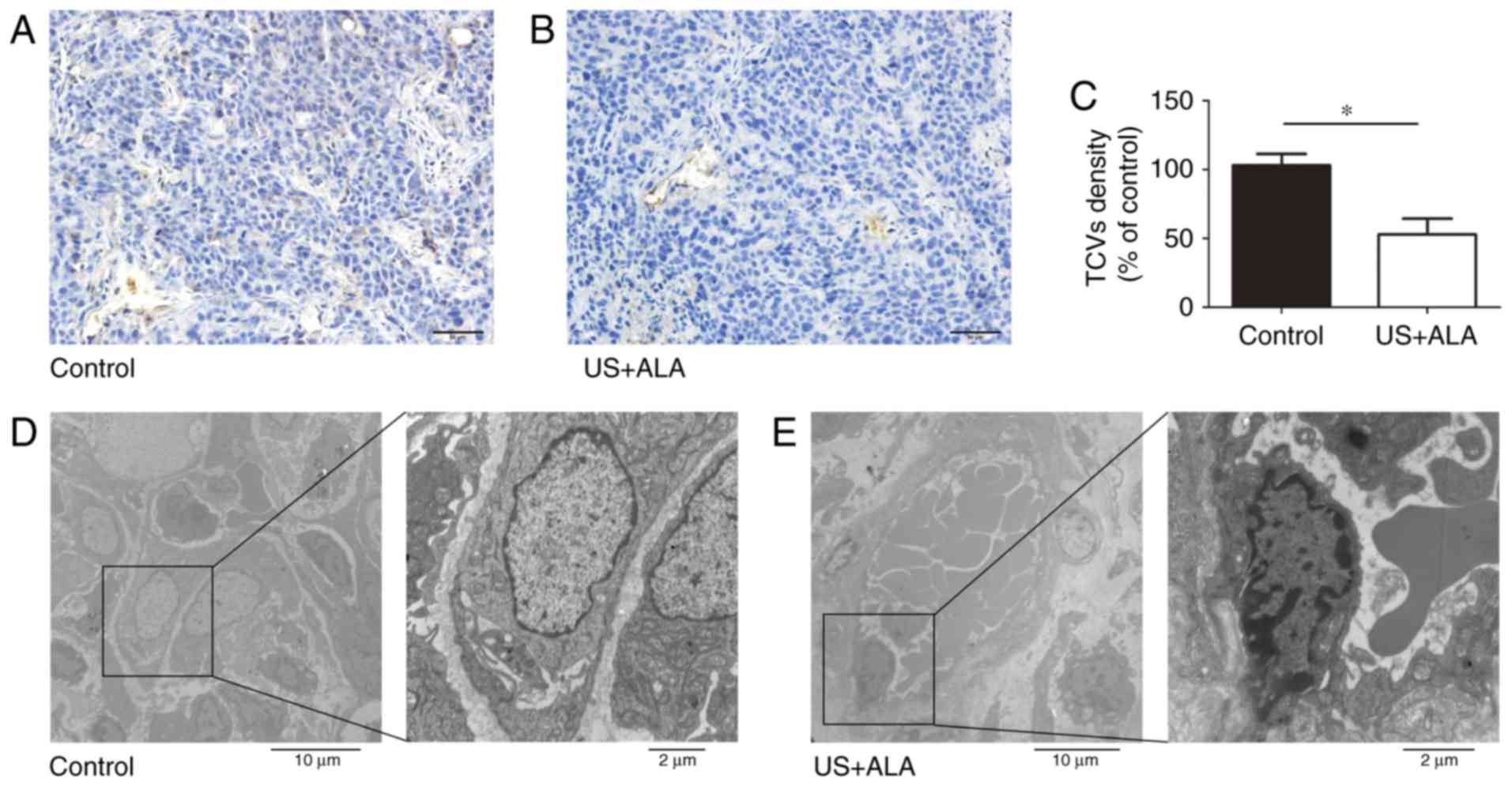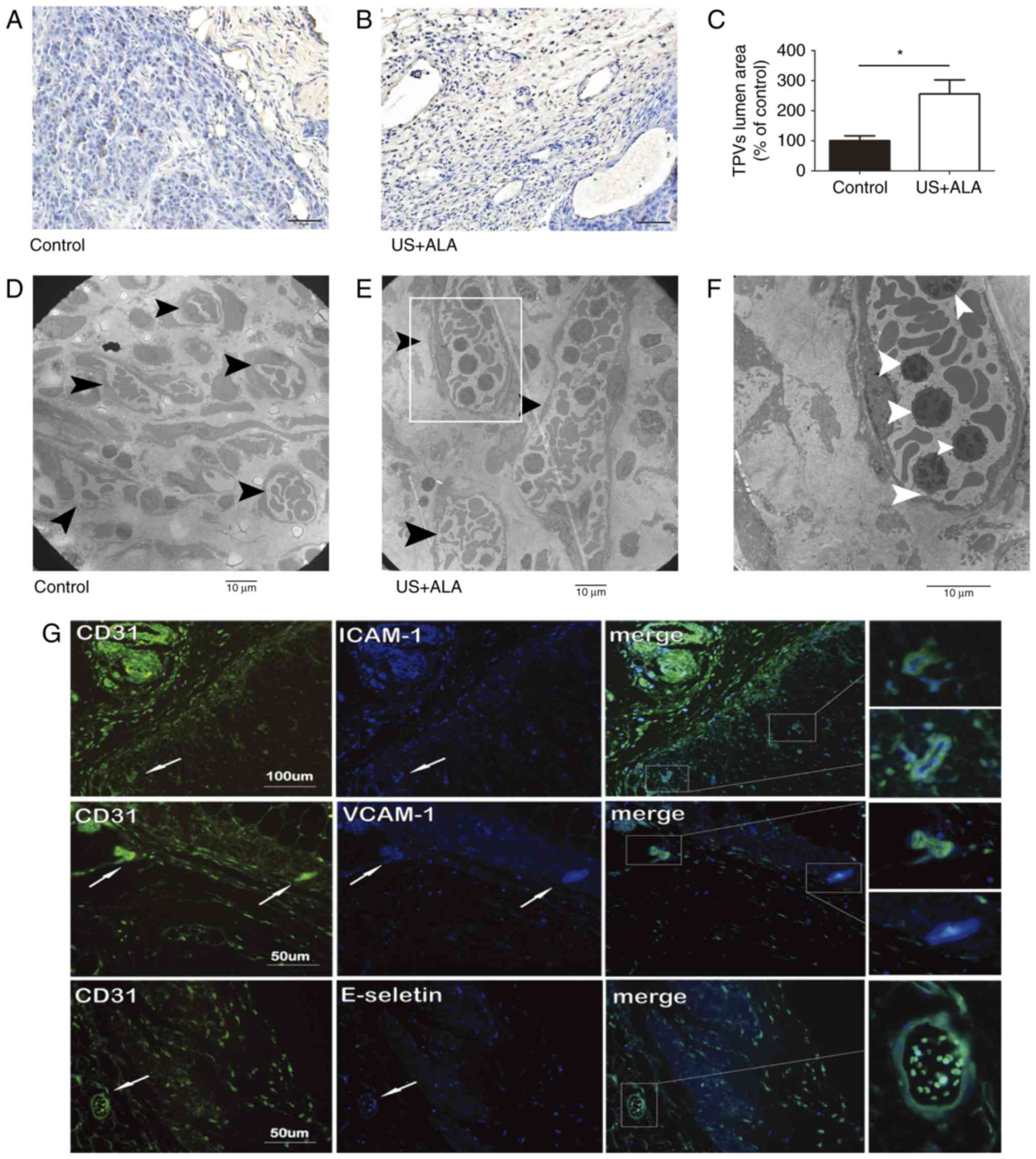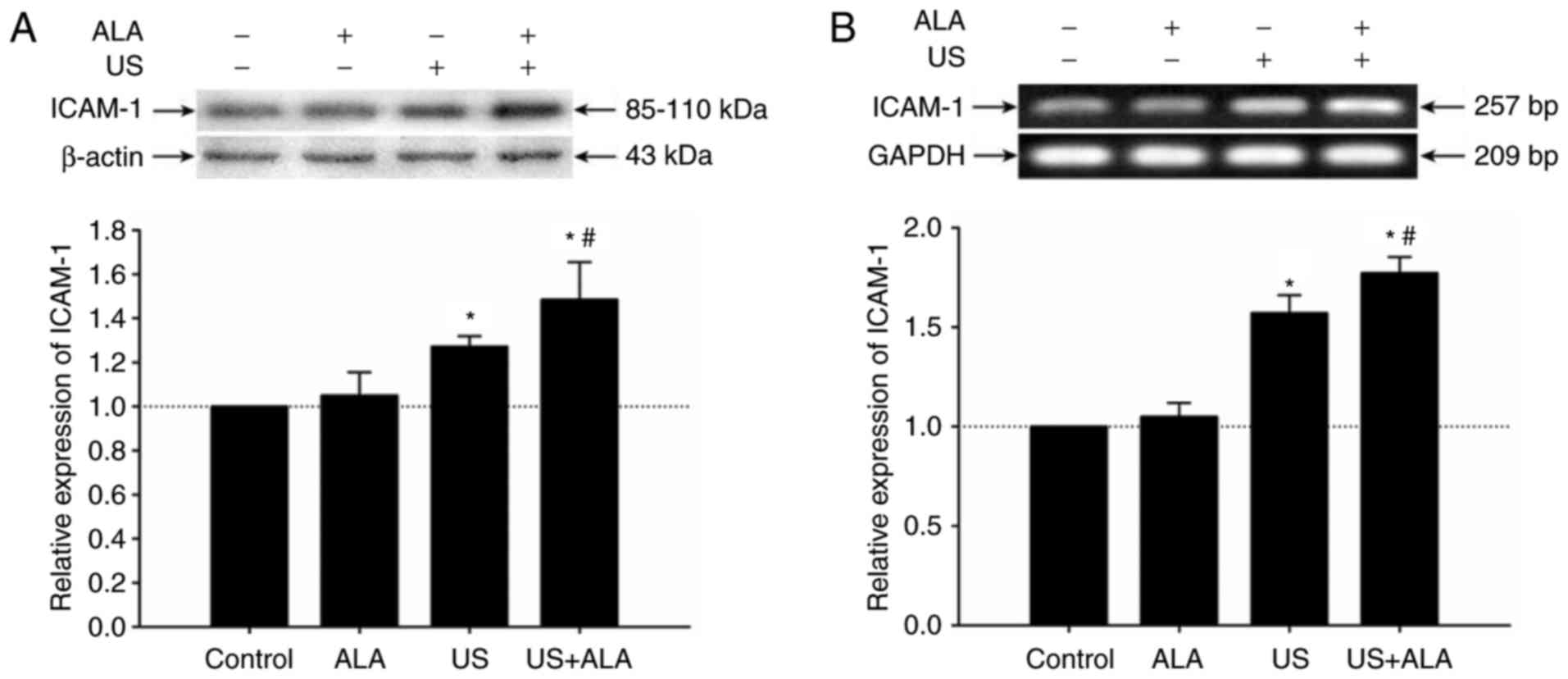|
1
|
Rosenthal I, Sostaric JZ and Riesz P:
Sonodynamic therapy - a review of the synergistic effects of drugs
and ultrasound. Ultrason Sonochem. 11:349–363. 2004.PubMed/NCBI
|
|
2
|
Shibaguchi H, Tsuru H and Kuroki M and
Kuroki M: Sonodynamic cancer therapy: A non-invasive and repeatable
approach using low-intensity ultrasound with a sonosensitizer.
Anticancer Res. 31:2425–2429. 2011.PubMed/NCBI
|
|
3
|
Li Y, Wang P, Zhao P, Zhu S, Wang X and
Liu Q: Apoptosis induced by sonodynamic treatment by protoporphyrin
IX on MDA-MB-231 cells. Ultrasonics. 52:490–496. 2012. View Article : Google Scholar : PubMed/NCBI
|
|
4
|
Wang X, Leung AW, Jiang Y, Yu H, Li X and
Xu C: Hypocrellin B-mediated sonodynamic action induces apoptosis
of hepatocellular carcinoma cells. Ultrasonics. 52:543–546. 2012.
View Article : Google Scholar : PubMed/NCBI
|
|
5
|
Wang X, Liu Q, Wang Z, Wang P, Zhao P,
Zhao X, Yang L and Li Y: Role of autophagy in sonodynamic
therapy-induced cytotoxicity in S180 cells. Ultrasound Med Biol.
36:1933–1946. 2010. View Article : Google Scholar : PubMed/NCBI
|
|
6
|
Su X, Wang P, Yang S, Zhang K, Liu Q and
Wang X: Sonodynamic therapy induces the interplay between apoptosis
and autophagy in K562 cells through ROS. Int J Biochem Cell Biol.
60:82–92. 2015. View Article : Google Scholar : PubMed/NCBI
|
|
7
|
Lv Y, Zheng J, Zhou Q, Jia L, Wang C, Liu
N, Zhao H, Ji H, Li B and Cao W: Antiproliferative and
Apoptosis-inducing effect of exo-Protoporphyrin IX based
sonodynamic therapy on human oral squamous cell carcinoma. Sci Rep.
7:409672017. View Article : Google Scholar : PubMed/NCBI
|
|
8
|
Hu Z, Fan H, Lv G, Zhou Q, Yang B, Zheng J
and Cao W: 5-Aminolevulinic acid-mediated sonodynamic therapy
induces anti-tumor effects in malignant melanoma via
p53-miR-34a-Sirt1 axis. J Dermatol Sci. 79:155–162. 2015.
View Article : Google Scholar : PubMed/NCBI
|
|
9
|
Li Y, Zhou Q, Hu Z, Yang B, Li Q, Wang J,
Zheng J and Cao W: 5-Aminolevulinic acid-based sonodynamic therapy
induces the apoptosis of osteosarcoma in mice. PLoS One.
10:e01320742015. View Article : Google Scholar : PubMed/NCBI
|
|
10
|
Gao Z, Zheng J, Yang B, Wang Z, Fan H, Lv
Y, Li H, Jia L and Cao W: Sonodynamic therapy inhibits angiogenesis
and tumor growth in a xenograft mouse model. Cancer Lett.
335:93–99. 2013. View Article : Google Scholar : PubMed/NCBI
|
|
11
|
Wang S, Hu Z, Wang X, Gu C, Gao Z, Cao W
and Zheng J: 5-Aminolevulinic acid-mediated sonodynamic therapy
reverses macrophage and dendritic cell passivity in murine melanoma
xenografts. Ultrasound Med Biol. 40:2125–2133. 2014. View Article : Google Scholar : PubMed/NCBI
|
|
12
|
Rosenberg SA, Spiess P and Lafreniere R: A
new approach to the adoptive immunotherapy of cancer with
tumor-infiltrating lymphocytes. Science. 233:1318–1321. 1986.
View Article : Google Scholar : PubMed/NCBI
|
|
13
|
Griffith KD, Read EJ, Carrasquillo JA,
Carter CS, Yang JC, Fisher B, Aebersold P, Packard BS, Yu MY and
Rosenberg SA: In vivo distribution of adoptively transferred
indium-111-labeled tumor infiltrating lymphocytes and peripheral
blood lymphocytes in patients with metastatic melanoma. J Natl
Cancer Inst. 81:1709–1717. 1989. View Article : Google Scholar : PubMed/NCBI
|
|
14
|
Balkwill F, Charles KA and Mantovani A:
Smoldering and polarized inflammation in the initiation and
promotion of malignant disease. Cancer Cell. 7:211–217. 2005.
View Article : Google Scholar : PubMed/NCBI
|
|
15
|
Galon J, Mlecnik B, Bindea G, Angell HK,
Berger A, Lagorce C, Lugli A, Zlobec I, Hartmann A, Bifulco C, et
al: Towards the introduction of the ‘Immunoscore’ in the
classification of malignant tumours. J Pathol. 232:199–209. 2014.
View Article : Google Scholar : PubMed/NCBI
|
|
16
|
Lv Y, Fang M, Zheng J, Yang B, Li H,
Xiuzigao Z, Song W, Chen Y and Cao W: Low-intensity ultrasound
combined with 5-aminolevulinic acid administration in the treatment
of human tongue squamous carcinoma. Cell Physiol Biochem.
30:321–333. 2012. View Article : Google Scholar : PubMed/NCBI
|
|
17
|
Tanchot C, Terme M, Pere H, Tran T,
Benhamouda N, Strioga M, Banissi C, Galluzzi L, Kroemer G and
Tartour E: Tumor-infiltrating regulatory T cells: Phenotype, role,
mechanism of expansion in situ and clinical significance. Cancer
Microenviron. 6:147–157. 2013. View Article : Google Scholar : PubMed/NCBI
|
|
18
|
Zhang L and Zhao Y: The regulation of
Foxp3 expression in regulatory CD4(+)CD25(+)T cells: Multiple
pathways on the road. J Cell Physiol. 211:590–597. 2007. View Article : Google Scholar : PubMed/NCBI
|
|
19
|
Marson A, Kretschmer K, Frampton GM,
Jacobsen ES, Polansky JK, MacIsaac KD, Levine SS, Fraenkel E, von
Boehmer H and Young RA: Foxp3 occupancy and regulation of key
target genes during T-cell stimulation. Nature. 445:931–935. 2007.
View Article : Google Scholar : PubMed/NCBI
|
|
20
|
Son CH, Bae JH, Shin DY, Lee HR, Choi YJ,
Jo WS, Jung Ho M, Kang CD, Yang K and Park YS: CTLA-4 blockade
enhances antitumor immunity of intratumoral injection of immature
dendritic cells into irradiated tumor in a mouse colon cancer
model. J Immunother. 37:1–7. 2014. View Article : Google Scholar : PubMed/NCBI
|
|
21
|
Sharpe AH: Mechanisms of costimulation.
Immunol Rev. 229:5–11. 2009. View Article : Google Scholar : PubMed/NCBI
|
|
22
|
Mauri D and Pichler WJ: Involvement of
CD80 in the generation of CD4+ cytotoxic T cells.
Immunol Res. 15:126–140. 1996. View Article : Google Scholar : PubMed/NCBI
|
|
23
|
Carriere V, Colisson R, Jiguet-Jiglaire C,
Bellard E, Bouche G, Al Saati T, Amalric F, Girard JP and M'Rini C:
Cancer cells regulate lymphocyte recruitment and
leukocyte-endothelium interactions in the tumor-draining lymph
node. Cancer Res. 65:11639–11648. 2005. View Article : Google Scholar : PubMed/NCBI
|
|
24
|
Griffioen AW, Damen CA, Martinotti S,
Blijham GH and Groenewegen G: Endothelial intercellular adhesion
molecule-1 expression is suppressed in human malignancies: The role
of angiogenic factors. Cancer Res. 56:1111–1117. 1996.PubMed/NCBI
|
|
25
|
Bandyopadhyay S, Quinn TJ, Scandiuzzi L,
Basu I, Partanen A, Tomé WA, Macian F and Guha C: Low-intensity
focused ultrasound induces reversal of tumor-induced T cell
tolerance and prevents immune escape. J Immunol. 196:1964–1976.
2016. View Article : Google Scholar : PubMed/NCBI
|
|
26
|
Liu HL, Hsieh HY, Lu LA, Kang CW, Wu MF
and Lin CY: Low-pressure pulsed focused ultrasound with
microbubbles promotes an anticancer immunological response. J
Transl Med. 10:2212012. View Article : Google Scholar : PubMed/NCBI
|



